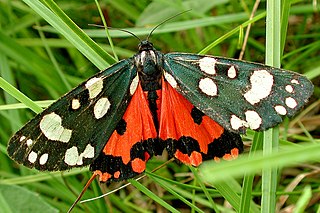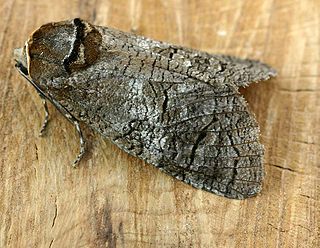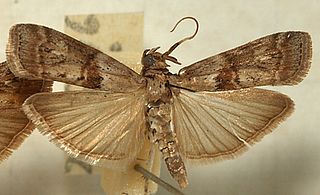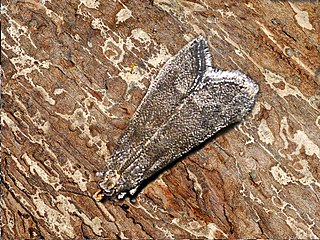Related Research Articles

The scarlet tiger moth is a colorful moth belonging to the tiger moth subfamily, Arctiinae. The species was first described by Carl Linnaeus in his 1758 10th edition of Systema Naturae.

The tawny speckled pug is a moth of the family Geometridae.

Krüper's nuthatch is a species of bird in the family Sittidae. It is a small to medium-sized nuthatch, measuring 12.5 centimetres (4.9 in) in length. The upperparts are blue-gray, with the front half of the crown black in adults of both sexes, but with a less marked in the female rear. The species has a black or gray eyestripe and a prominent white supercilium. The underparts are blue-gray in males and buff-gray in females, with a large, crescent-shaped rufous pectoral patch. The Krüper's nuthatch feeds on insects in the summer and seeds, especially pines, in the fall and winter. Breeding takes place between March and May, and the nest is usually placed in a tree hole. The clutch consists of five to seven eggs, incubated by the female and fed by the male. Both parents take part in feeding the young.

Otto Staudinger was a German entomologist and a natural history dealer considered one of the largest in the world specialising in the collection and sale of insects to museums, scientific institutions, and individuals.

Cossus cossus, the goat moth, is a moth of the family Cossidae. It is found in Northern Africa, Asia and Europe.

Harpella forficella is a species of the concealer moth family (Oecophoridae), wherein it belongs to subfamily Oecophorinae.
Nolasena is a monotypic moth genus of the family Erebidae. Its only species, Nolasena ferrifervens, is found in India, Sri Lanka, Borneo and the Philippines. Both the genus and species were first described by Francis Walker in 1858.

Chersotis cuprea is a moth of the family Noctuidae.

Ochsenheimeria taurella, the Liverpool feather-horn or the rye stem borer, is a moth of the family Ypsolophidae.

Phycita is a genus of small moths belonging to the snout moth family (Pyralidae). They are the type genus of their tribe Phycitini and of the huge snout moth subfamily Phycitinae.
Agdistopis sinhala is a moth of the family Macropiratidae. It is found in south-east Asia, including Sri Lanka, India, Japan and Taiwan.

Eccopisa is a genus of snout moths. It was described by Philipp Christoph Zeller in 1848.

Cossus is a genus of moths in the family Cossidae described by Johan Christian Fabricius in 1793.
Dyspessacossus is a genus of moths in the family Cossidae.
Cossus subocellatus is a moth in the family Cossidae. The distribution of the species is unknown.
Semagystia enigma is a moth in the family Cossidae. It was described by Yakovlev in 2007. It is found in Turkey.
Dyspessa blonda is a moth in the family Cossidae. It was described by Yakovlev in 2008. It is found in Turkey.
Dyspessa tyumasevae is a moth in the family Cossidae. It was described by Yakovlev in 2008. It is found in Turkey.
The Stygiinae Newman, 1832 are a subfamily of the family Cossidae.

Endoxyla cinereus, the giant wood moth, is a moth in the family Cossidae. It is found in Australia and New Zealand. The species was first described in 1890. A rare contemporary sighting of the moth at a school in Australia garnered notice as an editor's pick among the daily headlines of the New York Times on May 8, 2021.
References
- ↑ Beccaloni, G.; Scoble, M.; Kitching, I.; Simonsen, T.; Robinson, G.; Pitkin, B.; Hine, A.; Lyal, C., eds. (2003). "Dyspessacossus funkei". The Global Lepidoptera Names Index . Natural History Museum. Retrieved April 20, 2018.
- ↑ Yakovlev, R.V., 2011: Catalogue of the Family Cossidae of the Old World. Neue Entomologische Nachrichten, 66: 1-129.
- 1 2 3 4 5 6 7 8 9 10 Röber, Von (1896). "Ein neuer Trypanus aus dem palaearktischen Gebiete" (PDF). zobodat.at. Retrieved 24 March 2021.
{{cite web}}: CS1 maint: url-status (link)